Leadership Report on Styles, Culture, and Diversity Management
VerifiedAdded on 2022/12/29
|10
|2637
|54
Report
AI Summary
This report delves into the multifaceted concept of leadership, exploring its significance in enhancing company performance and achieving organizational objectives. It begins by defining leadership as the art of influencing and guiding employees towards goal attainment, emphasizing the integration of individual and collective goals. The report then examines various leadership styles, including autocratic, democratic, and laissez-faire approaches, and discusses their impact on employee involvement and decision-making. Furthermore, it analyzes several leadership theories, such as situational, contingency, transformational, and transactional theories, highlighting their applicability in different contexts. The report also investigates organizational culture, its functions, and the influence of leaders on shaping it. It explores Handy's model of organizational culture, encompassing power, task, person, and role cultures. Finally, the report addresses diversity management, emphasizing the importance of leadership commitment, coaching, flexible work culture, and effective communication in fostering an inclusive and equitable work environment.
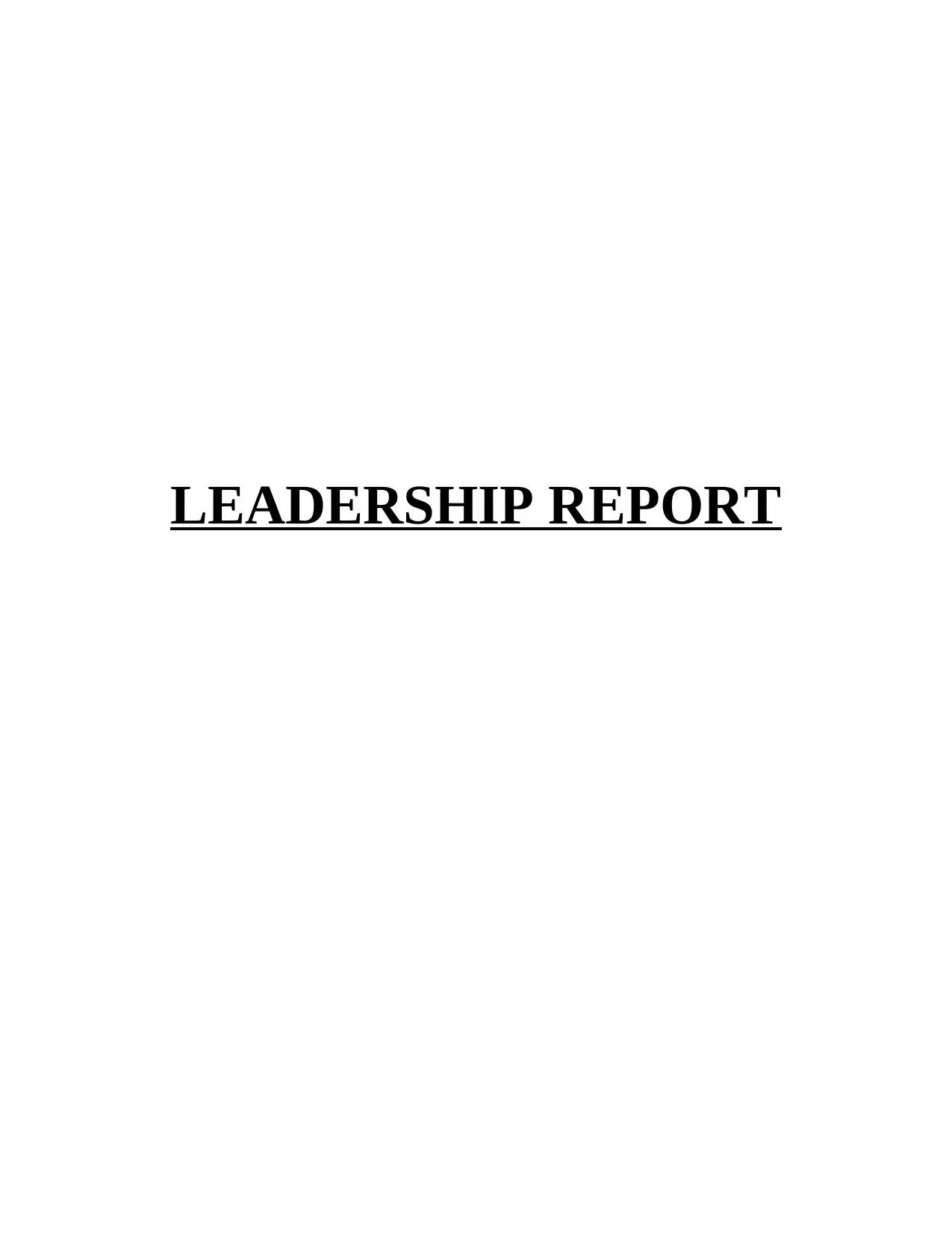
LEADERSHIP REPORT
Paraphrase This Document
Need a fresh take? Get an instant paraphrase of this document with our AI Paraphraser
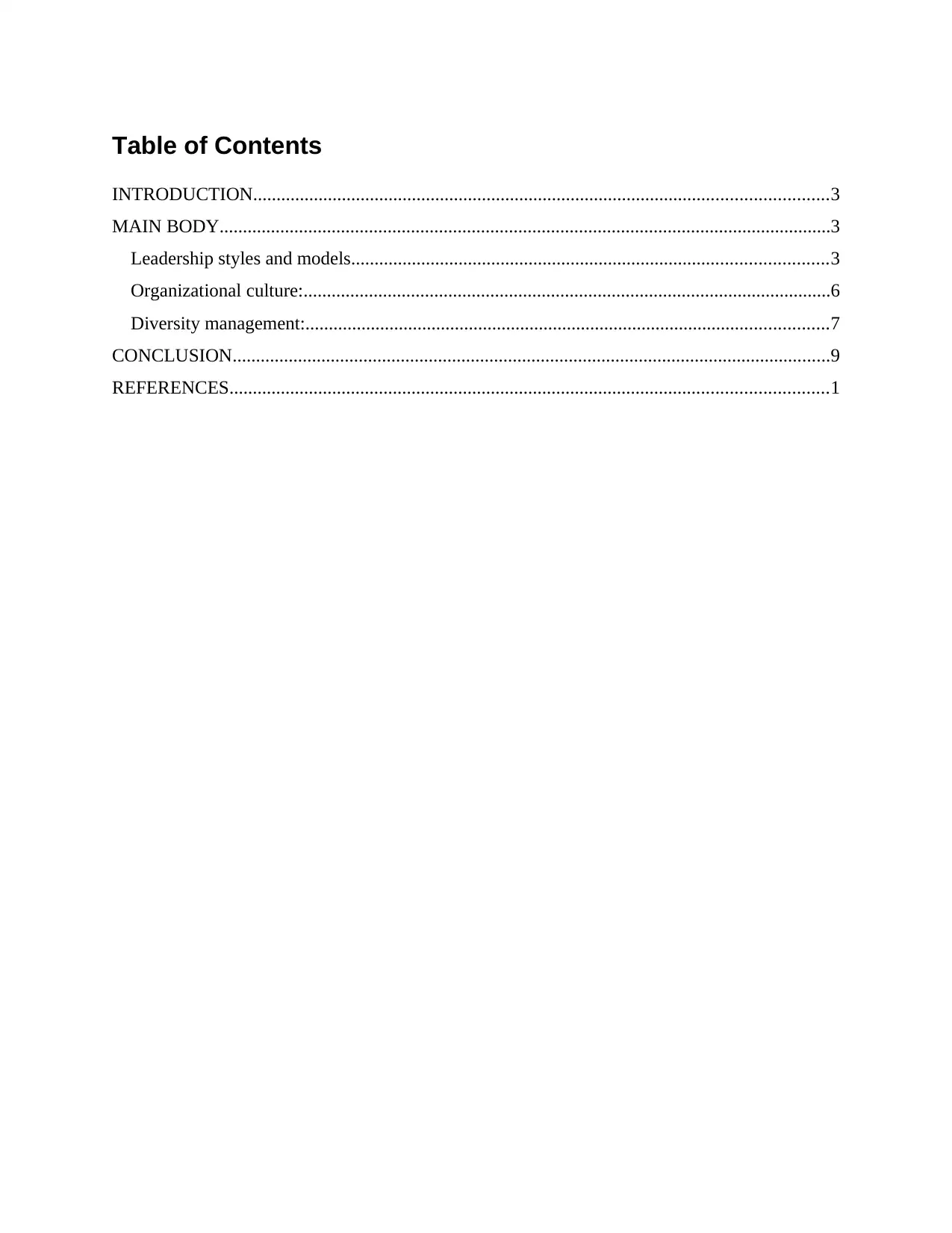
Table of Contents
INTRODUCTION...........................................................................................................................3
MAIN BODY...................................................................................................................................3
Leadership styles and models......................................................................................................3
Organizational culture:.................................................................................................................6
Diversity management:................................................................................................................7
CONCLUSION................................................................................................................................9
REFERENCES................................................................................................................................1
INTRODUCTION...........................................................................................................................3
MAIN BODY...................................................................................................................................3
Leadership styles and models......................................................................................................3
Organizational culture:.................................................................................................................6
Diversity management:................................................................................................................7
CONCLUSION................................................................................................................................9
REFERENCES................................................................................................................................1
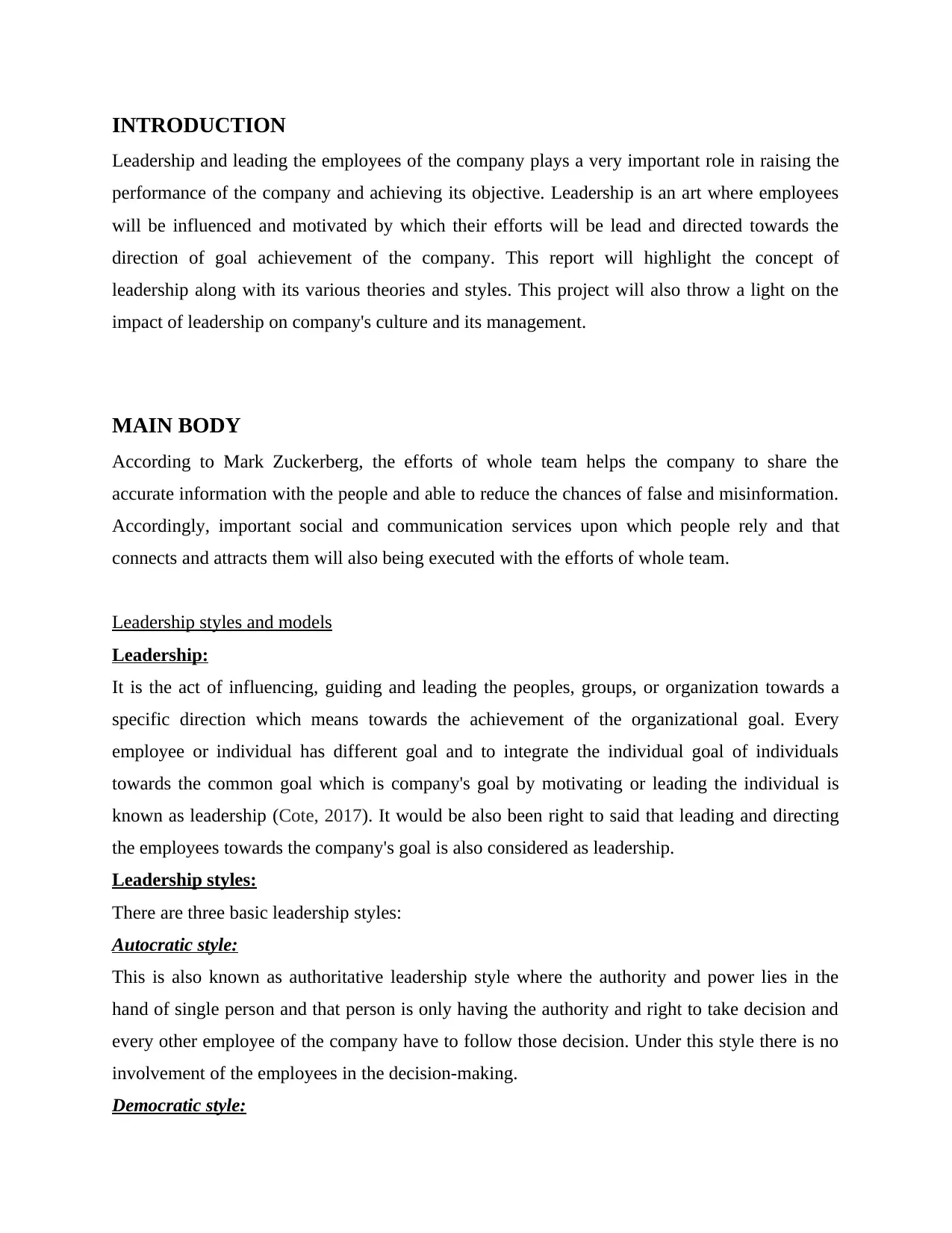
INTRODUCTION
Leadership and leading the employees of the company plays a very important role in raising the
performance of the company and achieving its objective. Leadership is an art where employees
will be influenced and motivated by which their efforts will be lead and directed towards the
direction of goal achievement of the company. This report will highlight the concept of
leadership along with its various theories and styles. This project will also throw a light on the
impact of leadership on company's culture and its management.
MAIN BODY
According to Mark Zuckerberg, the efforts of whole team helps the company to share the
accurate information with the people and able to reduce the chances of false and misinformation.
Accordingly, important social and communication services upon which people rely and that
connects and attracts them will also being executed with the efforts of whole team.
Leadership styles and models
Leadership:
It is the act of influencing, guiding and leading the peoples, groups, or organization towards a
specific direction which means towards the achievement of the organizational goal. Every
employee or individual has different goal and to integrate the individual goal of individuals
towards the common goal which is company's goal by motivating or leading the individual is
known as leadership (Cote, 2017). It would be also been right to said that leading and directing
the employees towards the company's goal is also considered as leadership.
Leadership styles:
There are three basic leadership styles:
Autocratic style:
This is also known as authoritative leadership style where the authority and power lies in the
hand of single person and that person is only having the authority and right to take decision and
every other employee of the company have to follow those decision. Under this style there is no
involvement of the employees in the decision-making.
Democratic style:
Leadership and leading the employees of the company plays a very important role in raising the
performance of the company and achieving its objective. Leadership is an art where employees
will be influenced and motivated by which their efforts will be lead and directed towards the
direction of goal achievement of the company. This report will highlight the concept of
leadership along with its various theories and styles. This project will also throw a light on the
impact of leadership on company's culture and its management.
MAIN BODY
According to Mark Zuckerberg, the efforts of whole team helps the company to share the
accurate information with the people and able to reduce the chances of false and misinformation.
Accordingly, important social and communication services upon which people rely and that
connects and attracts them will also being executed with the efforts of whole team.
Leadership styles and models
Leadership:
It is the act of influencing, guiding and leading the peoples, groups, or organization towards a
specific direction which means towards the achievement of the organizational goal. Every
employee or individual has different goal and to integrate the individual goal of individuals
towards the common goal which is company's goal by motivating or leading the individual is
known as leadership (Cote, 2017). It would be also been right to said that leading and directing
the employees towards the company's goal is also considered as leadership.
Leadership styles:
There are three basic leadership styles:
Autocratic style:
This is also known as authoritative leadership style where the authority and power lies in the
hand of single person and that person is only having the authority and right to take decision and
every other employee of the company have to follow those decision. Under this style there is no
involvement of the employees in the decision-making.
Democratic style:
⊘ This is a preview!⊘
Do you want full access?
Subscribe today to unlock all pages.

Trusted by 1+ million students worldwide
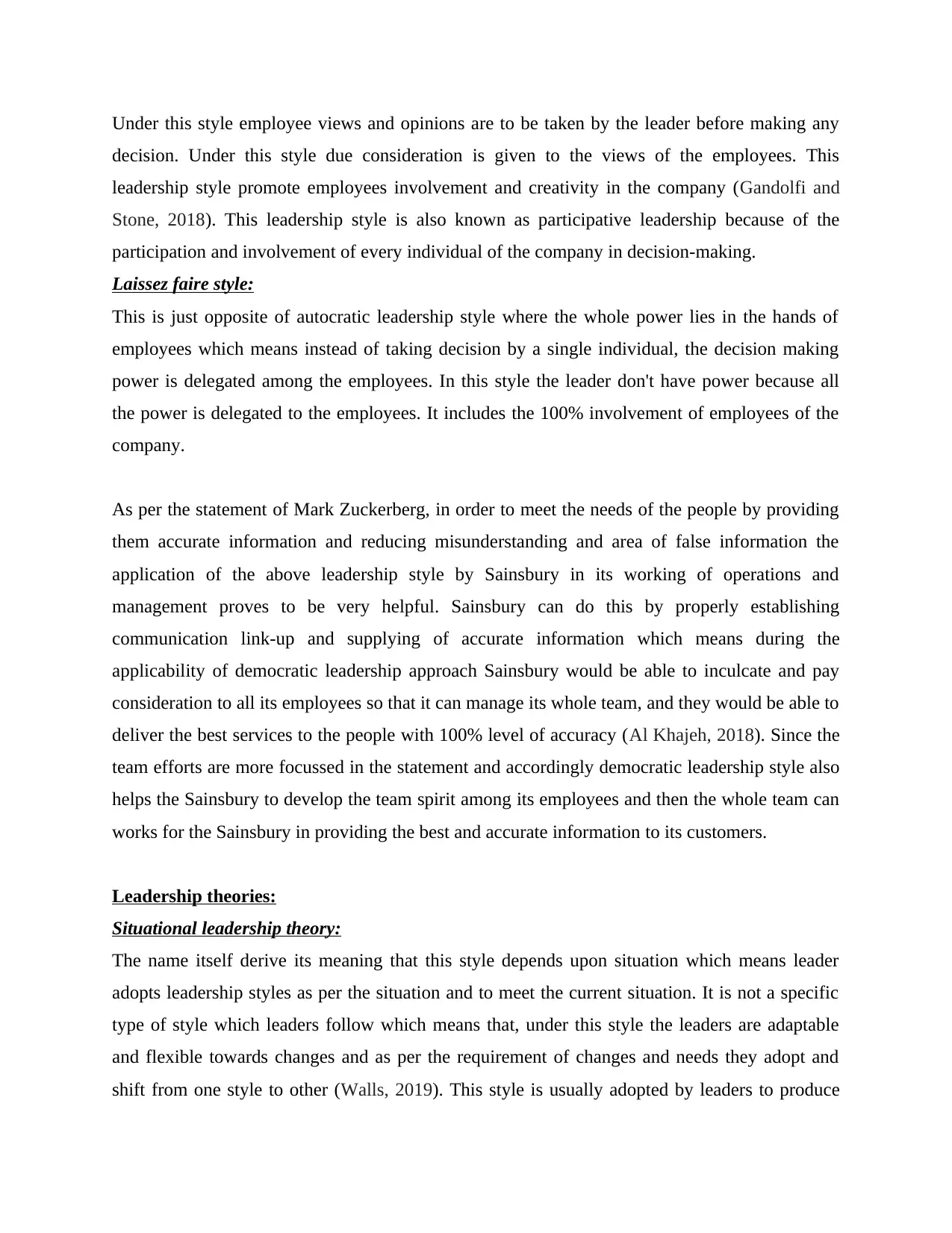
Under this style employee views and opinions are to be taken by the leader before making any
decision. Under this style due consideration is given to the views of the employees. This
leadership style promote employees involvement and creativity in the company (Gandolfi and
Stone, 2018). This leadership style is also known as participative leadership because of the
participation and involvement of every individual of the company in decision-making.
Laissez faire style:
This is just opposite of autocratic leadership style where the whole power lies in the hands of
employees which means instead of taking decision by a single individual, the decision making
power is delegated among the employees. In this style the leader don't have power because all
the power is delegated to the employees. It includes the 100% involvement of employees of the
company.
As per the statement of Mark Zuckerberg, in order to meet the needs of the people by providing
them accurate information and reducing misunderstanding and area of false information the
application of the above leadership style by Sainsbury in its working of operations and
management proves to be very helpful. Sainsbury can do this by properly establishing
communication link-up and supplying of accurate information which means during the
applicability of democratic leadership approach Sainsbury would be able to inculcate and pay
consideration to all its employees so that it can manage its whole team, and they would be able to
deliver the best services to the people with 100% level of accuracy (Al Khajeh, 2018). Since the
team efforts are more focussed in the statement and accordingly democratic leadership style also
helps the Sainsbury to develop the team spirit among its employees and then the whole team can
works for the Sainsbury in providing the best and accurate information to its customers.
Leadership theories:
Situational leadership theory:
The name itself derive its meaning that this style depends upon situation which means leader
adopts leadership styles as per the situation and to meet the current situation. It is not a specific
type of style which leaders follow which means that, under this style the leaders are adaptable
and flexible towards changes and as per the requirement of changes and needs they adopt and
shift from one style to other (Walls, 2019). This style is usually adopted by leaders to produce
decision. Under this style due consideration is given to the views of the employees. This
leadership style promote employees involvement and creativity in the company (Gandolfi and
Stone, 2018). This leadership style is also known as participative leadership because of the
participation and involvement of every individual of the company in decision-making.
Laissez faire style:
This is just opposite of autocratic leadership style where the whole power lies in the hands of
employees which means instead of taking decision by a single individual, the decision making
power is delegated among the employees. In this style the leader don't have power because all
the power is delegated to the employees. It includes the 100% involvement of employees of the
company.
As per the statement of Mark Zuckerberg, in order to meet the needs of the people by providing
them accurate information and reducing misunderstanding and area of false information the
application of the above leadership style by Sainsbury in its working of operations and
management proves to be very helpful. Sainsbury can do this by properly establishing
communication link-up and supplying of accurate information which means during the
applicability of democratic leadership approach Sainsbury would be able to inculcate and pay
consideration to all its employees so that it can manage its whole team, and they would be able to
deliver the best services to the people with 100% level of accuracy (Al Khajeh, 2018). Since the
team efforts are more focussed in the statement and accordingly democratic leadership style also
helps the Sainsbury to develop the team spirit among its employees and then the whole team can
works for the Sainsbury in providing the best and accurate information to its customers.
Leadership theories:
Situational leadership theory:
The name itself derive its meaning that this style depends upon situation which means leader
adopts leadership styles as per the situation and to meet the current situation. It is not a specific
type of style which leaders follow which means that, under this style the leaders are adaptable
and flexible towards changes and as per the requirement of changes and needs they adopt and
shift from one style to other (Walls, 2019). This style is usually adopted by leaders to produce
Paraphrase This Document
Need a fresh take? Get an instant paraphrase of this document with our AI Paraphraser
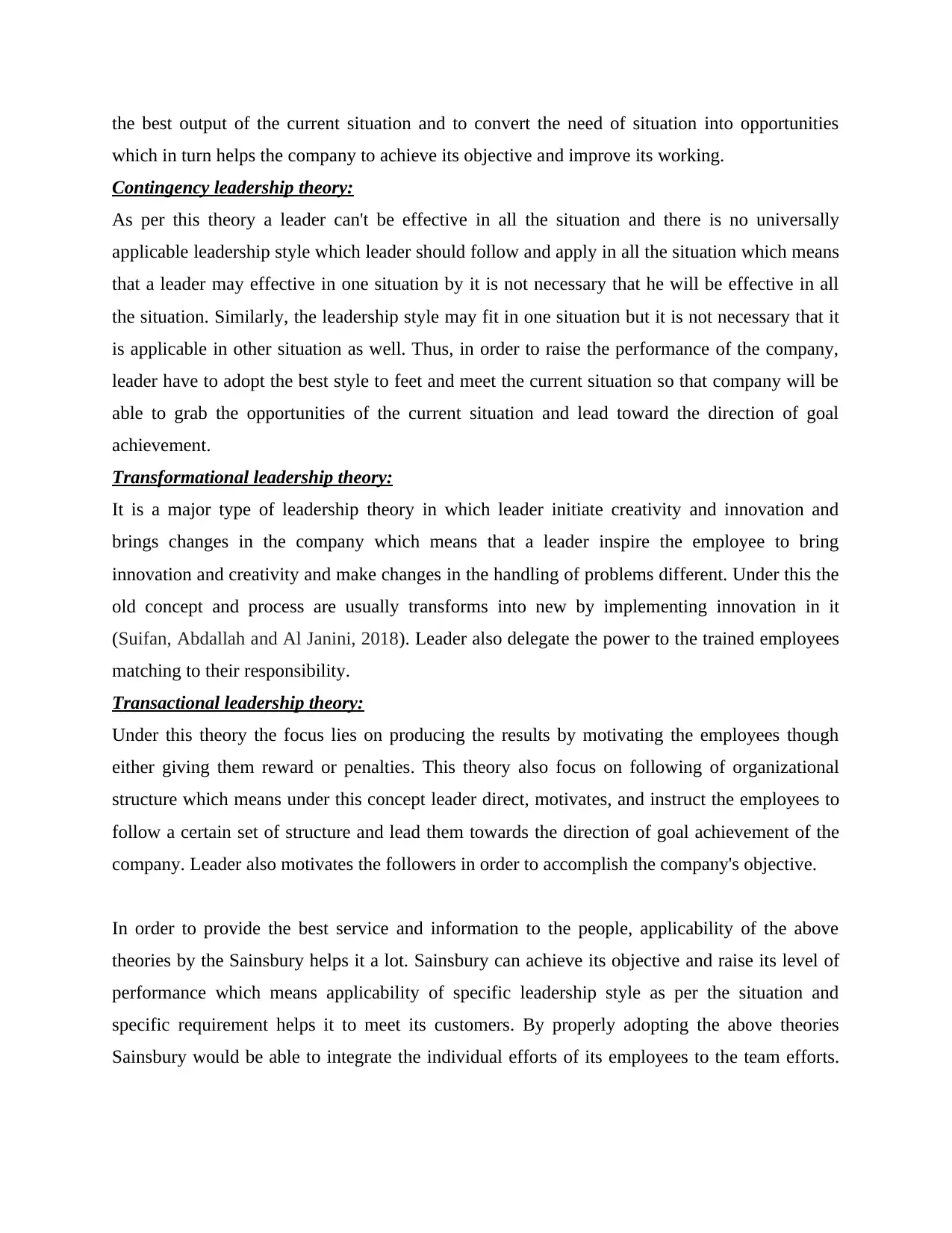
the best output of the current situation and to convert the need of situation into opportunities
which in turn helps the company to achieve its objective and improve its working.
Contingency leadership theory:
As per this theory a leader can't be effective in all the situation and there is no universally
applicable leadership style which leader should follow and apply in all the situation which means
that a leader may effective in one situation by it is not necessary that he will be effective in all
the situation. Similarly, the leadership style may fit in one situation but it is not necessary that it
is applicable in other situation as well. Thus, in order to raise the performance of the company,
leader have to adopt the best style to feet and meet the current situation so that company will be
able to grab the opportunities of the current situation and lead toward the direction of goal
achievement.
Transformational leadership theory:
It is a major type of leadership theory in which leader initiate creativity and innovation and
brings changes in the company which means that a leader inspire the employee to bring
innovation and creativity and make changes in the handling of problems different. Under this the
old concept and process are usually transforms into new by implementing innovation in it
(Suifan, Abdallah and Al Janini, 2018). Leader also delegate the power to the trained employees
matching to their responsibility.
Transactional leadership theory:
Under this theory the focus lies on producing the results by motivating the employees though
either giving them reward or penalties. This theory also focus on following of organizational
structure which means under this concept leader direct, motivates, and instruct the employees to
follow a certain set of structure and lead them towards the direction of goal achievement of the
company. Leader also motivates the followers in order to accomplish the company's objective.
In order to provide the best service and information to the people, applicability of the above
theories by the Sainsbury helps it a lot. Sainsbury can achieve its objective and raise its level of
performance which means applicability of specific leadership style as per the situation and
specific requirement helps it to meet its customers. By properly adopting the above theories
Sainsbury would be able to integrate the individual efforts of its employees to the team efforts.
which in turn helps the company to achieve its objective and improve its working.
Contingency leadership theory:
As per this theory a leader can't be effective in all the situation and there is no universally
applicable leadership style which leader should follow and apply in all the situation which means
that a leader may effective in one situation by it is not necessary that he will be effective in all
the situation. Similarly, the leadership style may fit in one situation but it is not necessary that it
is applicable in other situation as well. Thus, in order to raise the performance of the company,
leader have to adopt the best style to feet and meet the current situation so that company will be
able to grab the opportunities of the current situation and lead toward the direction of goal
achievement.
Transformational leadership theory:
It is a major type of leadership theory in which leader initiate creativity and innovation and
brings changes in the company which means that a leader inspire the employee to bring
innovation and creativity and make changes in the handling of problems different. Under this the
old concept and process are usually transforms into new by implementing innovation in it
(Suifan, Abdallah and Al Janini, 2018). Leader also delegate the power to the trained employees
matching to their responsibility.
Transactional leadership theory:
Under this theory the focus lies on producing the results by motivating the employees though
either giving them reward or penalties. This theory also focus on following of organizational
structure which means under this concept leader direct, motivates, and instruct the employees to
follow a certain set of structure and lead them towards the direction of goal achievement of the
company. Leader also motivates the followers in order to accomplish the company's objective.
In order to provide the best service and information to the people, applicability of the above
theories by the Sainsbury helps it a lot. Sainsbury can achieve its objective and raise its level of
performance which means applicability of specific leadership style as per the situation and
specific requirement helps it to meet its customers. By properly adopting the above theories
Sainsbury would be able to integrate the individual efforts of its employees to the team efforts.
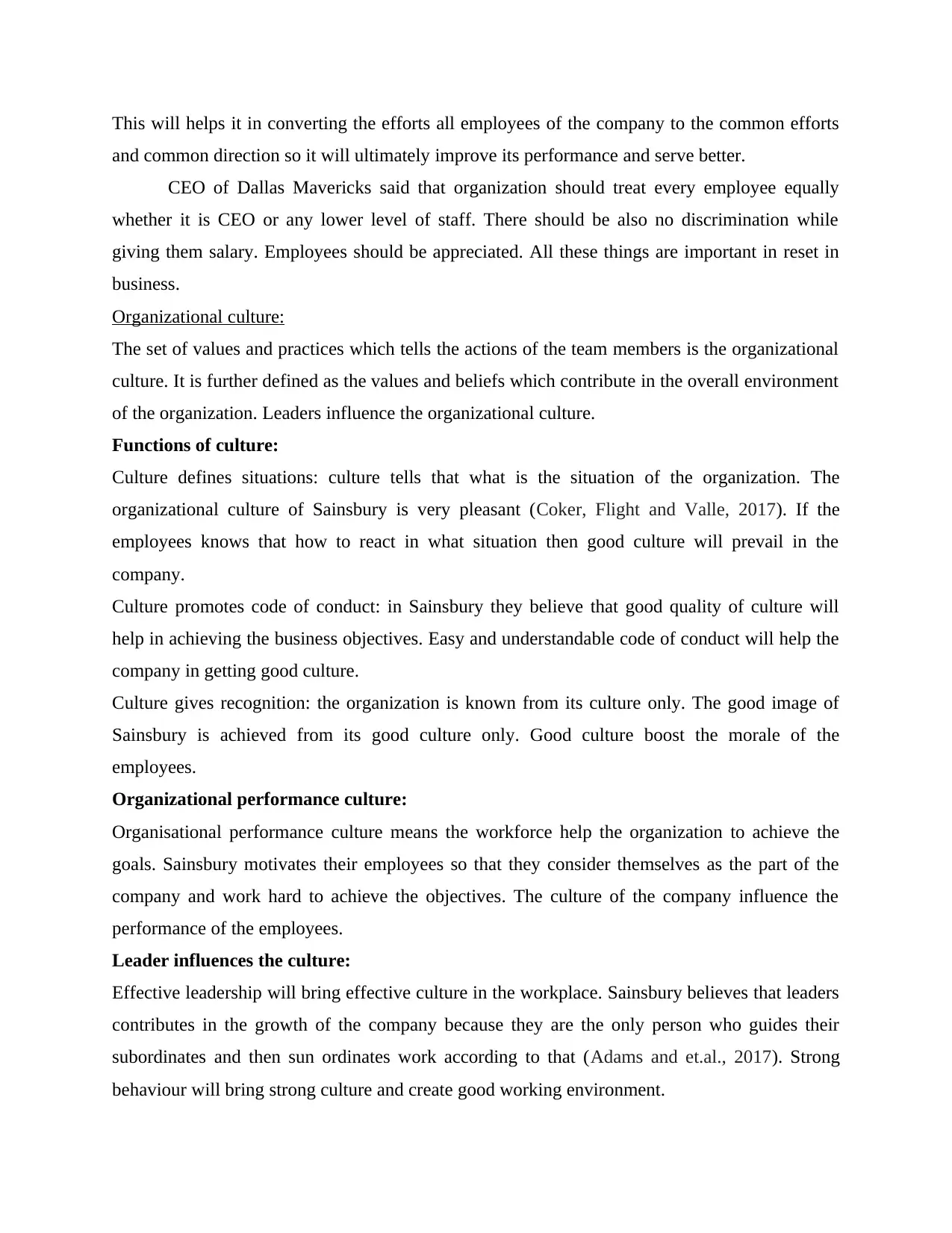
This will helps it in converting the efforts all employees of the company to the common efforts
and common direction so it will ultimately improve its performance and serve better.
CEO of Dallas Mavericks said that organization should treat every employee equally
whether it is CEO or any lower level of staff. There should be also no discrimination while
giving them salary. Employees should be appreciated. All these things are important in reset in
business.
Organizational culture:
The set of values and practices which tells the actions of the team members is the organizational
culture. It is further defined as the values and beliefs which contribute in the overall environment
of the organization. Leaders influence the organizational culture.
Functions of culture:
Culture defines situations: culture tells that what is the situation of the organization. The
organizational culture of Sainsbury is very pleasant (Coker, Flight and Valle, 2017). If the
employees knows that how to react in what situation then good culture will prevail in the
company.
Culture promotes code of conduct: in Sainsbury they believe that good quality of culture will
help in achieving the business objectives. Easy and understandable code of conduct will help the
company in getting good culture.
Culture gives recognition: the organization is known from its culture only. The good image of
Sainsbury is achieved from its good culture only. Good culture boost the morale of the
employees.
Organizational performance culture:
Organisational performance culture means the workforce help the organization to achieve the
goals. Sainsbury motivates their employees so that they consider themselves as the part of the
company and work hard to achieve the objectives. The culture of the company influence the
performance of the employees.
Leader influences the culture:
Effective leadership will bring effective culture in the workplace. Sainsbury believes that leaders
contributes in the growth of the company because they are the only person who guides their
subordinates and then sun ordinates work according to that (Adams and et.al., 2017). Strong
behaviour will bring strong culture and create good working environment.
and common direction so it will ultimately improve its performance and serve better.
CEO of Dallas Mavericks said that organization should treat every employee equally
whether it is CEO or any lower level of staff. There should be also no discrimination while
giving them salary. Employees should be appreciated. All these things are important in reset in
business.
Organizational culture:
The set of values and practices which tells the actions of the team members is the organizational
culture. It is further defined as the values and beliefs which contribute in the overall environment
of the organization. Leaders influence the organizational culture.
Functions of culture:
Culture defines situations: culture tells that what is the situation of the organization. The
organizational culture of Sainsbury is very pleasant (Coker, Flight and Valle, 2017). If the
employees knows that how to react in what situation then good culture will prevail in the
company.
Culture promotes code of conduct: in Sainsbury they believe that good quality of culture will
help in achieving the business objectives. Easy and understandable code of conduct will help the
company in getting good culture.
Culture gives recognition: the organization is known from its culture only. The good image of
Sainsbury is achieved from its good culture only. Good culture boost the morale of the
employees.
Organizational performance culture:
Organisational performance culture means the workforce help the organization to achieve the
goals. Sainsbury motivates their employees so that they consider themselves as the part of the
company and work hard to achieve the objectives. The culture of the company influence the
performance of the employees.
Leader influences the culture:
Effective leadership will bring effective culture in the workplace. Sainsbury believes that leaders
contributes in the growth of the company because they are the only person who guides their
subordinates and then sun ordinates work according to that (Adams and et.al., 2017). Strong
behaviour will bring strong culture and create good working environment.
⊘ This is a preview!⊘
Do you want full access?
Subscribe today to unlock all pages.

Trusted by 1+ million students worldwide
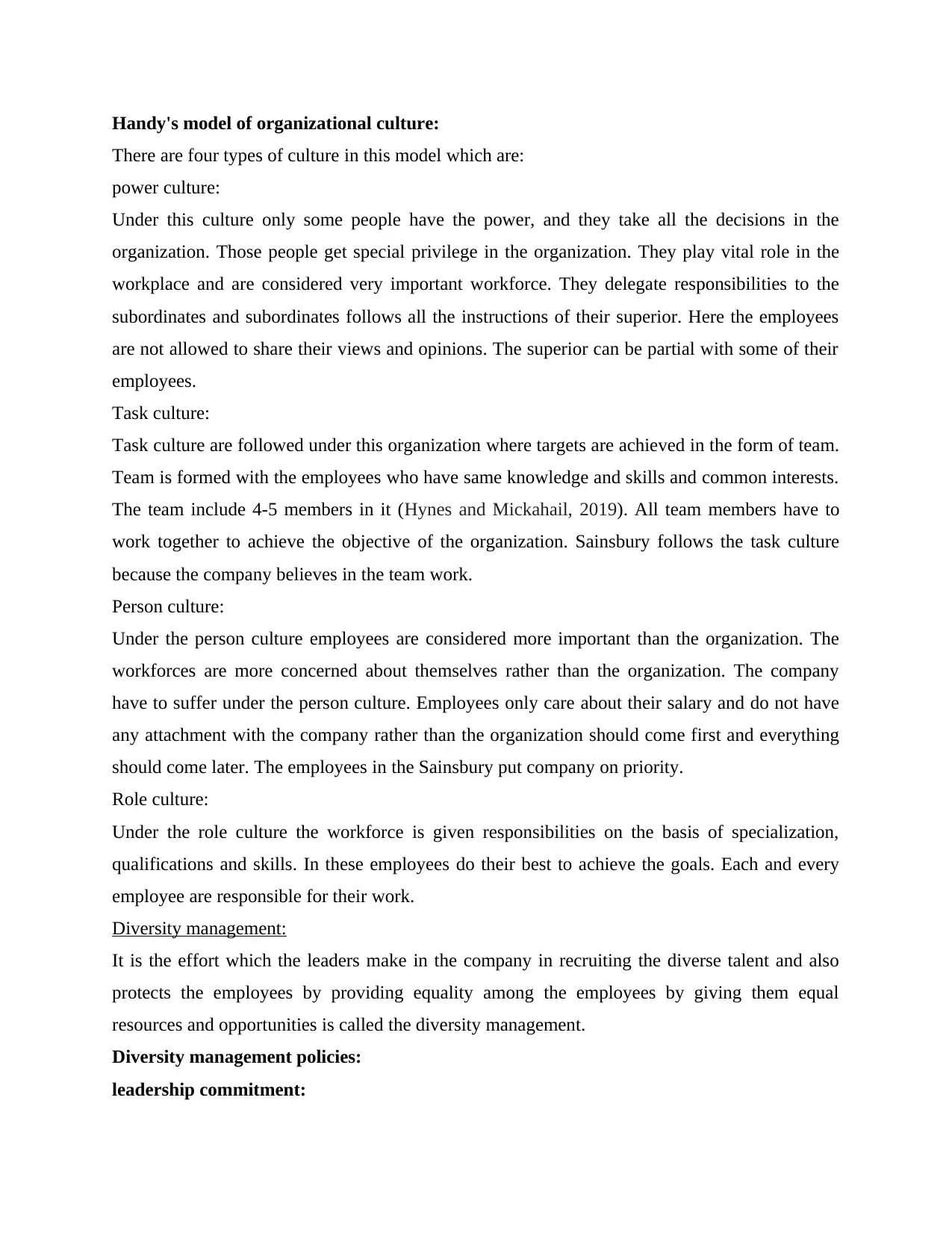
Handy's model of organizational culture:
There are four types of culture in this model which are:
power culture:
Under this culture only some people have the power, and they take all the decisions in the
organization. Those people get special privilege in the organization. They play vital role in the
workplace and are considered very important workforce. They delegate responsibilities to the
subordinates and subordinates follows all the instructions of their superior. Here the employees
are not allowed to share their views and opinions. The superior can be partial with some of their
employees.
Task culture:
Task culture are followed under this organization where targets are achieved in the form of team.
Team is formed with the employees who have same knowledge and skills and common interests.
The team include 4-5 members in it (Hynes and Mickahail, 2019). All team members have to
work together to achieve the objective of the organization. Sainsbury follows the task culture
because the company believes in the team work.
Person culture:
Under the person culture employees are considered more important than the organization. The
workforces are more concerned about themselves rather than the organization. The company
have to suffer under the person culture. Employees only care about their salary and do not have
any attachment with the company rather than the organization should come first and everything
should come later. The employees in the Sainsbury put company on priority.
Role culture:
Under the role culture the workforce is given responsibilities on the basis of specialization,
qualifications and skills. In these employees do their best to achieve the goals. Each and every
employee are responsible for their work.
Diversity management:
It is the effort which the leaders make in the company in recruiting the diverse talent and also
protects the employees by providing equality among the employees by giving them equal
resources and opportunities is called the diversity management.
Diversity management policies:
leadership commitment:
There are four types of culture in this model which are:
power culture:
Under this culture only some people have the power, and they take all the decisions in the
organization. Those people get special privilege in the organization. They play vital role in the
workplace and are considered very important workforce. They delegate responsibilities to the
subordinates and subordinates follows all the instructions of their superior. Here the employees
are not allowed to share their views and opinions. The superior can be partial with some of their
employees.
Task culture:
Task culture are followed under this organization where targets are achieved in the form of team.
Team is formed with the employees who have same knowledge and skills and common interests.
The team include 4-5 members in it (Hynes and Mickahail, 2019). All team members have to
work together to achieve the objective of the organization. Sainsbury follows the task culture
because the company believes in the team work.
Person culture:
Under the person culture employees are considered more important than the organization. The
workforces are more concerned about themselves rather than the organization. The company
have to suffer under the person culture. Employees only care about their salary and do not have
any attachment with the company rather than the organization should come first and everything
should come later. The employees in the Sainsbury put company on priority.
Role culture:
Under the role culture the workforce is given responsibilities on the basis of specialization,
qualifications and skills. In these employees do their best to achieve the goals. Each and every
employee are responsible for their work.
Diversity management:
It is the effort which the leaders make in the company in recruiting the diverse talent and also
protects the employees by providing equality among the employees by giving them equal
resources and opportunities is called the diversity management.
Diversity management policies:
leadership commitment:
Paraphrase This Document
Need a fresh take? Get an instant paraphrase of this document with our AI Paraphraser
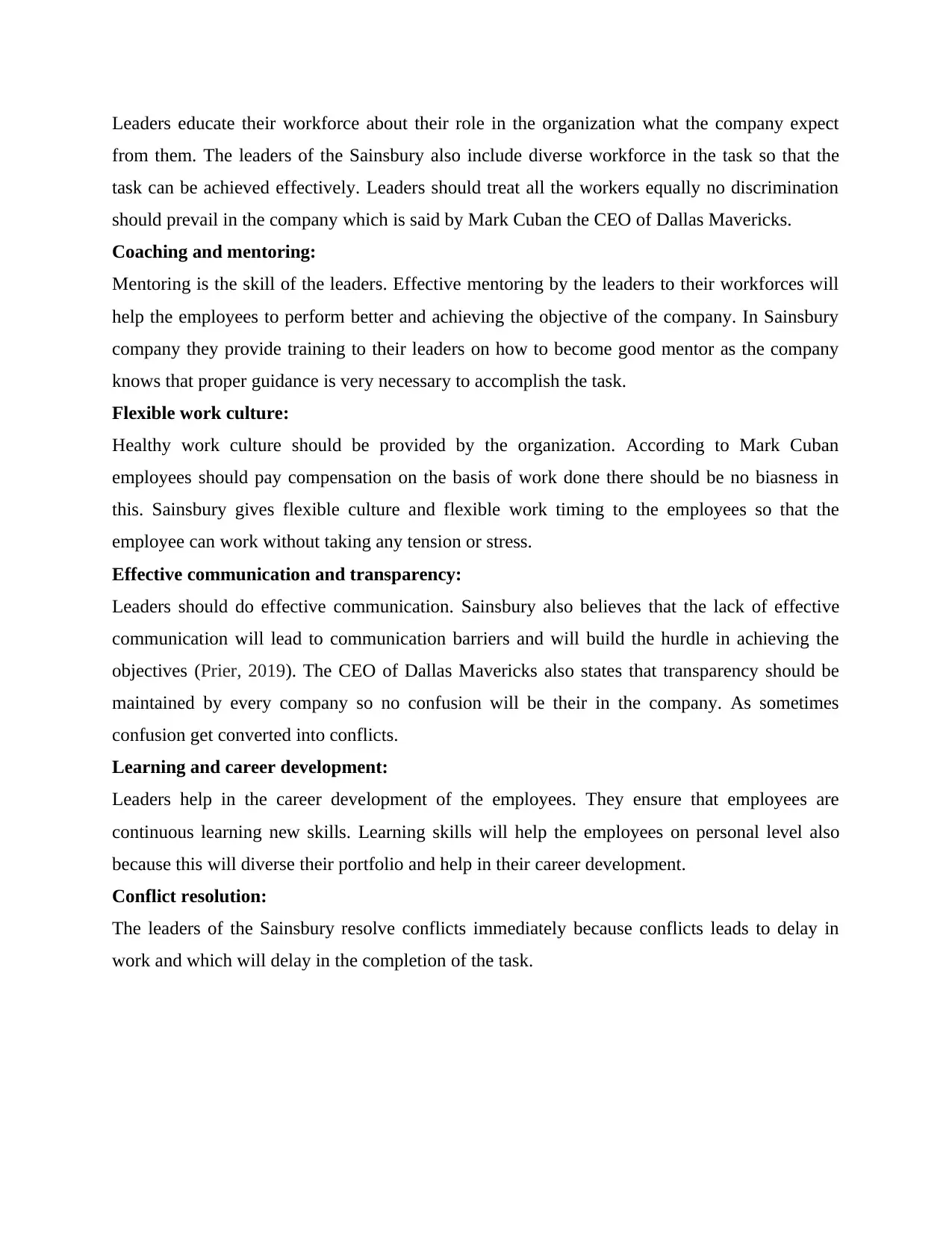
Leaders educate their workforce about their role in the organization what the company expect
from them. The leaders of the Sainsbury also include diverse workforce in the task so that the
task can be achieved effectively. Leaders should treat all the workers equally no discrimination
should prevail in the company which is said by Mark Cuban the CEO of Dallas Mavericks.
Coaching and mentoring:
Mentoring is the skill of the leaders. Effective mentoring by the leaders to their workforces will
help the employees to perform better and achieving the objective of the company. In Sainsbury
company they provide training to their leaders on how to become good mentor as the company
knows that proper guidance is very necessary to accomplish the task.
Flexible work culture:
Healthy work culture should be provided by the organization. According to Mark Cuban
employees should pay compensation on the basis of work done there should be no biasness in
this. Sainsbury gives flexible culture and flexible work timing to the employees so that the
employee can work without taking any tension or stress.
Effective communication and transparency:
Leaders should do effective communication. Sainsbury also believes that the lack of effective
communication will lead to communication barriers and will build the hurdle in achieving the
objectives (Prier, 2019). The CEO of Dallas Mavericks also states that transparency should be
maintained by every company so no confusion will be their in the company. As sometimes
confusion get converted into conflicts.
Learning and career development:
Leaders help in the career development of the employees. They ensure that employees are
continuous learning new skills. Learning skills will help the employees on personal level also
because this will diverse their portfolio and help in their career development.
Conflict resolution:
The leaders of the Sainsbury resolve conflicts immediately because conflicts leads to delay in
work and which will delay in the completion of the task.
from them. The leaders of the Sainsbury also include diverse workforce in the task so that the
task can be achieved effectively. Leaders should treat all the workers equally no discrimination
should prevail in the company which is said by Mark Cuban the CEO of Dallas Mavericks.
Coaching and mentoring:
Mentoring is the skill of the leaders. Effective mentoring by the leaders to their workforces will
help the employees to perform better and achieving the objective of the company. In Sainsbury
company they provide training to their leaders on how to become good mentor as the company
knows that proper guidance is very necessary to accomplish the task.
Flexible work culture:
Healthy work culture should be provided by the organization. According to Mark Cuban
employees should pay compensation on the basis of work done there should be no biasness in
this. Sainsbury gives flexible culture and flexible work timing to the employees so that the
employee can work without taking any tension or stress.
Effective communication and transparency:
Leaders should do effective communication. Sainsbury also believes that the lack of effective
communication will lead to communication barriers and will build the hurdle in achieving the
objectives (Prier, 2019). The CEO of Dallas Mavericks also states that transparency should be
maintained by every company so no confusion will be their in the company. As sometimes
confusion get converted into conflicts.
Learning and career development:
Leaders help in the career development of the employees. They ensure that employees are
continuous learning new skills. Learning skills will help the employees on personal level also
because this will diverse their portfolio and help in their career development.
Conflict resolution:
The leaders of the Sainsbury resolve conflicts immediately because conflicts leads to delay in
work and which will delay in the completion of the task.
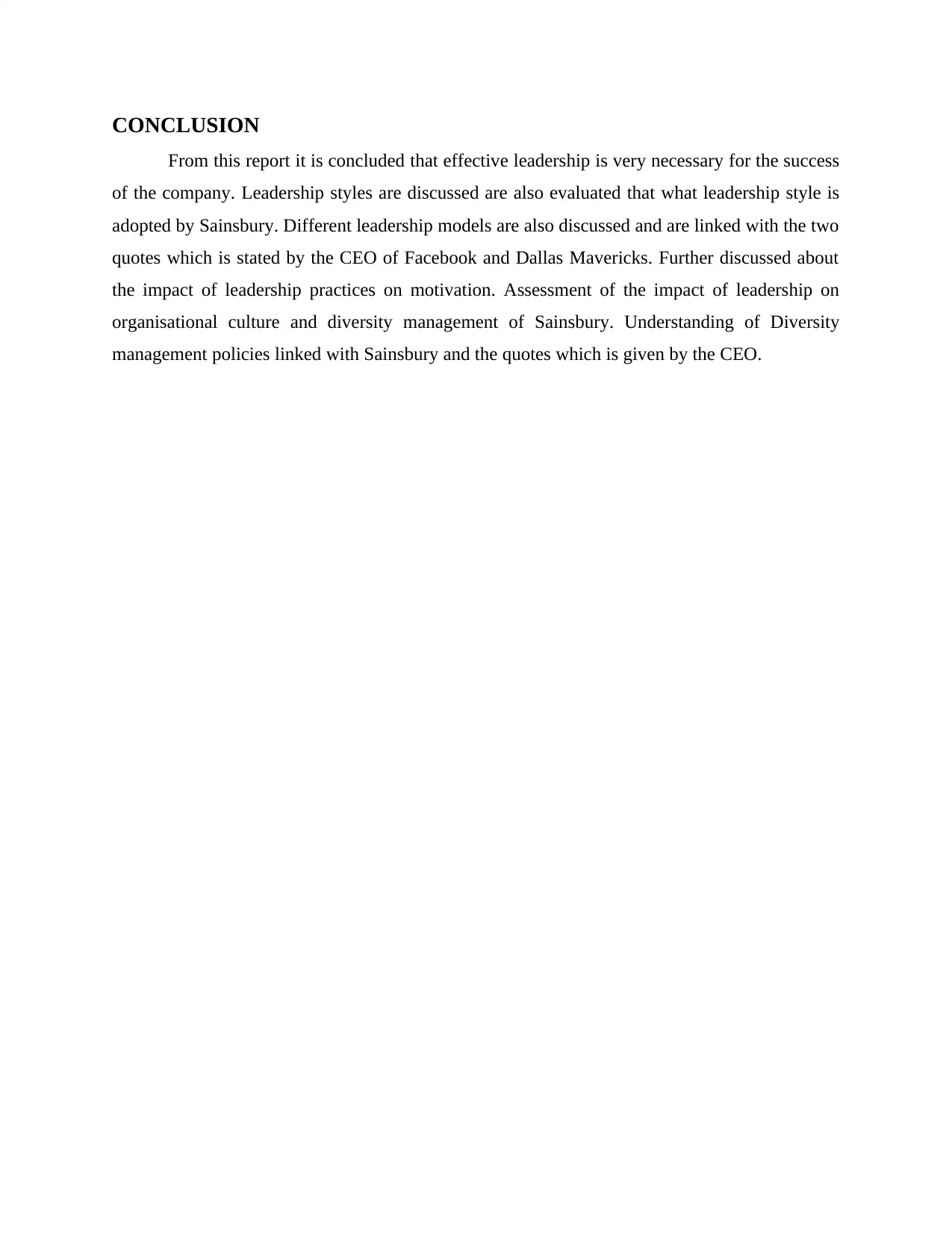
CONCLUSION
From this report it is concluded that effective leadership is very necessary for the success
of the company. Leadership styles are discussed are also evaluated that what leadership style is
adopted by Sainsbury. Different leadership models are also discussed and are linked with the two
quotes which is stated by the CEO of Facebook and Dallas Mavericks. Further discussed about
the impact of leadership practices on motivation. Assessment of the impact of leadership on
organisational culture and diversity management of Sainsbury. Understanding of Diversity
management policies linked with Sainsbury and the quotes which is given by the CEO.
From this report it is concluded that effective leadership is very necessary for the success
of the company. Leadership styles are discussed are also evaluated that what leadership style is
adopted by Sainsbury. Different leadership models are also discussed and are linked with the two
quotes which is stated by the CEO of Facebook and Dallas Mavericks. Further discussed about
the impact of leadership practices on motivation. Assessment of the impact of leadership on
organisational culture and diversity management of Sainsbury. Understanding of Diversity
management policies linked with Sainsbury and the quotes which is given by the CEO.
⊘ This is a preview!⊘
Do you want full access?
Subscribe today to unlock all pages.

Trusted by 1+ million students worldwide
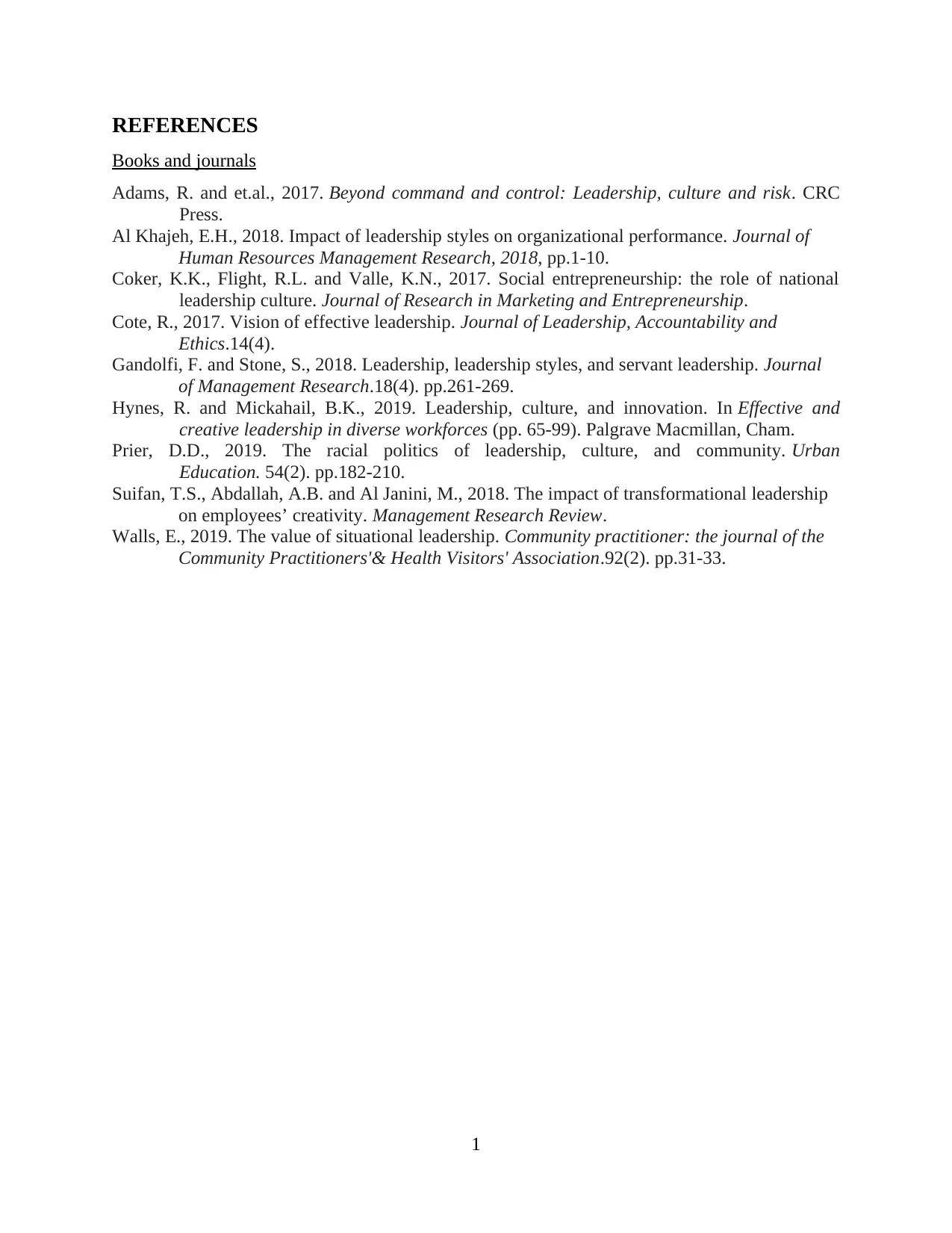
REFERENCES
Books and journals
Adams, R. and et.al., 2017. Beyond command and control: Leadership, culture and risk. CRC
Press.
Al Khajeh, E.H., 2018. Impact of leadership styles on organizational performance. Journal of
Human Resources Management Research, 2018, pp.1-10.
Coker, K.K., Flight, R.L. and Valle, K.N., 2017. Social entrepreneurship: the role of national
leadership culture. Journal of Research in Marketing and Entrepreneurship.
Cote, R., 2017. Vision of effective leadership. Journal of Leadership, Accountability and
Ethics.14(4).
Gandolfi, F. and Stone, S., 2018. Leadership, leadership styles, and servant leadership. Journal
of Management Research.18(4). pp.261-269.
Hynes, R. and Mickahail, B.K., 2019. Leadership, culture, and innovation. In Effective and
creative leadership in diverse workforces (pp. 65-99). Palgrave Macmillan, Cham.
Prier, D.D., 2019. The racial politics of leadership, culture, and community. Urban
Education. 54(2). pp.182-210.
Suifan, T.S., Abdallah, A.B. and Al Janini, M., 2018. The impact of transformational leadership
on employees’ creativity. Management Research Review.
Walls, E., 2019. The value of situational leadership. Community practitioner: the journal of the
Community Practitioners'& Health Visitors' Association.92(2). pp.31-33.
1
Books and journals
Adams, R. and et.al., 2017. Beyond command and control: Leadership, culture and risk. CRC
Press.
Al Khajeh, E.H., 2018. Impact of leadership styles on organizational performance. Journal of
Human Resources Management Research, 2018, pp.1-10.
Coker, K.K., Flight, R.L. and Valle, K.N., 2017. Social entrepreneurship: the role of national
leadership culture. Journal of Research in Marketing and Entrepreneurship.
Cote, R., 2017. Vision of effective leadership. Journal of Leadership, Accountability and
Ethics.14(4).
Gandolfi, F. and Stone, S., 2018. Leadership, leadership styles, and servant leadership. Journal
of Management Research.18(4). pp.261-269.
Hynes, R. and Mickahail, B.K., 2019. Leadership, culture, and innovation. In Effective and
creative leadership in diverse workforces (pp. 65-99). Palgrave Macmillan, Cham.
Prier, D.D., 2019. The racial politics of leadership, culture, and community. Urban
Education. 54(2). pp.182-210.
Suifan, T.S., Abdallah, A.B. and Al Janini, M., 2018. The impact of transformational leadership
on employees’ creativity. Management Research Review.
Walls, E., 2019. The value of situational leadership. Community practitioner: the journal of the
Community Practitioners'& Health Visitors' Association.92(2). pp.31-33.
1
1 out of 10
Related Documents
Your All-in-One AI-Powered Toolkit for Academic Success.
+13062052269
info@desklib.com
Available 24*7 on WhatsApp / Email
![[object Object]](/_next/static/media/star-bottom.7253800d.svg)
Unlock your academic potential
Copyright © 2020–2025 A2Z Services. All Rights Reserved. Developed and managed by ZUCOL.





